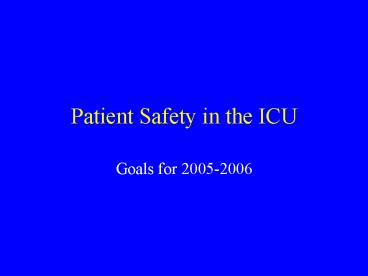Patient Safety in the ICU - PowerPoint PPT Presentation
1 / 13
Title:
Patient Safety in the ICU
Description:
Multi-disciplinary rounds. Sedation and Analgesia protocol. Ventilator Bundle. Central line Bundle ... Protocol for adequate resuscitation during the first 6 ... – PowerPoint PPT presentation
Number of Views:2611
Avg rating:3.0/5.0
Title: Patient Safety in the ICU
1
Patient Safety in the ICU
- Goals for 2005-2006
2
What has been accomplished?2003-2004
- Critical Care Committee for system
- Multi-disciplinary rounds
- Sedation and Analgesia protocol
- Ventilator Bundle
- Central line Bundle
- Intensive insulin therapy
- Ventilator weaning and liberation protocol
3
Goals2005 -2006
- Establishment of the Fundamental Critical Care
Support (FCCS) course (MUH) - Early Goal Directed Therapy for septic shock
(Surviving Sepsis Campaign) (MG) - Lower TV mechanical ventilation for patients with
ARDS/ALI (Surviving Sepsis Campaign) (MS) - Development of a patient safety program in the
ICU (MN)
4
Patient Safety Program
- Epidemiology
- 44,000 - 98,000 deaths each year in the US from
medical errors - every patient in the ICU has an adverse event
- System Factors have the largest impact on safety
- available equipment, staffing (nurses,
physicians, pharmacist), policies and protocols,
work environment - COMMUNICATION is vital in identifying factors
that might contribute to patient harm (change in
culture) - Establish a SAFETY PROGRAM
- www.patientsafetygroup.org (login jhopkins
password jhopkins)
5
Safety Programexample
- Meet once monthly specifically to discuss patient
safety - Learn about potential adverse outcomes by asking
- How are we going to harm the next patient? - Create an environment that encourages those who
work in the ICU to communicate concerns about
patient safety without consequences - Implement improvement measures
- Document improvement
- Executive participation
6
EGDTNEJM 20013451368-1377
- Protocol for adequate resuscitation during the
first 6 hours of severe sepsis. In-hospital
mortality was 16 less in the treatment group. - Goals CVP 8 -12 mmHg, MAP gt 65 mmHg, UOP gt 0.5
ml/kg/hr, and CV or MV oxygen sat gt 70 - keys
- early identification of patients with
sepsis-induced hypoperfusion (hypotension and
lactic acidosis) - initiation of protocol in the EMD
- placement of CL or PAC to measure CV or MV O2 sat
7
Low TV Strategy for ALI/ARDSARDS Network (NEJM
20003421301-1308)
- High tidal volumes associated with elevated
plateau pressures should be avoided in ALI/ARDS.
Patients ventilated with a tidal volume of 6
ml/kg preferred body weight had an approximate
reduction in mortality of 9 compared to patients
receiving a tidal volume of 12 ml/kg - Keys to success
- identifying patients at risk for ALI/ARDS
- best method to determine proper tidal volume
(bedside calculation or chart) and maintaining
IPP lt 30 cm H2O - education especially about tolerance of higher RR
/or PaCO2
8
FCCSFundamental Critical Care Support
- Two day course in basic critical care for the
nonintensivist sponsored by the Society of Crit
Care Med - Target audience
- physicians (hospitalists, emergency room
physicians) - nurses (CCRN, ACNP)
- PA
- physicians-in-training
- Lectures life-threatening infections, acute
respiratory failure, mechanical ventilation,
management of shock, etc. - Skill stations airway management, mechanical
ventilation, vascular access, etc.
9
FCCSWhat will participants learn?
- Assess needs and initiate treatment for the
critically ill patient - Respond to changes in the unstable patient
- Identify appropriate diagnostic test
- Recognize need for patient transfer or expert
consultation
10
FCCSAdvantages
- Extended hour coverage
- 24/7 inhouse intensivist program for 1 ICU
requires 5 full time intensivists and cost over 1
million per year - Leapfrog recognizes coverage by physician
extenders completing the FCCS course as compliant - Encourages compliance with evidence based
protocols and guidelines - Public Relations (new for the surrounding area)
- PATIENT SAFETY
11
FCCSWhat do we need to do?
- Administrative support
- sponsor application
- financial
- course coordinator
- equipment for skill stations
- room for lectures and skill stations
- Choose date
- Arrange for course consultant (1st course only)
- Arrange for lecturers and skill station helpers
12
(No Transcript)
13
SummaryWeb sites
- www.ihi.org
- www.survivingsepsis.org
- www.patientsafetygroup.org
- password jhopkins
- login jhopkins
- www.icusrs.org (ICU safety reporting system)






























